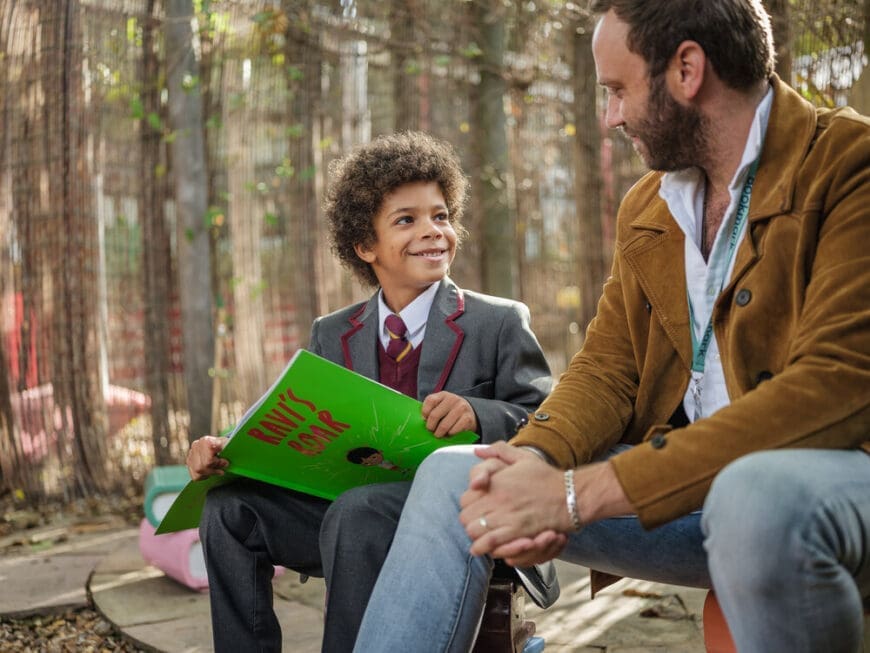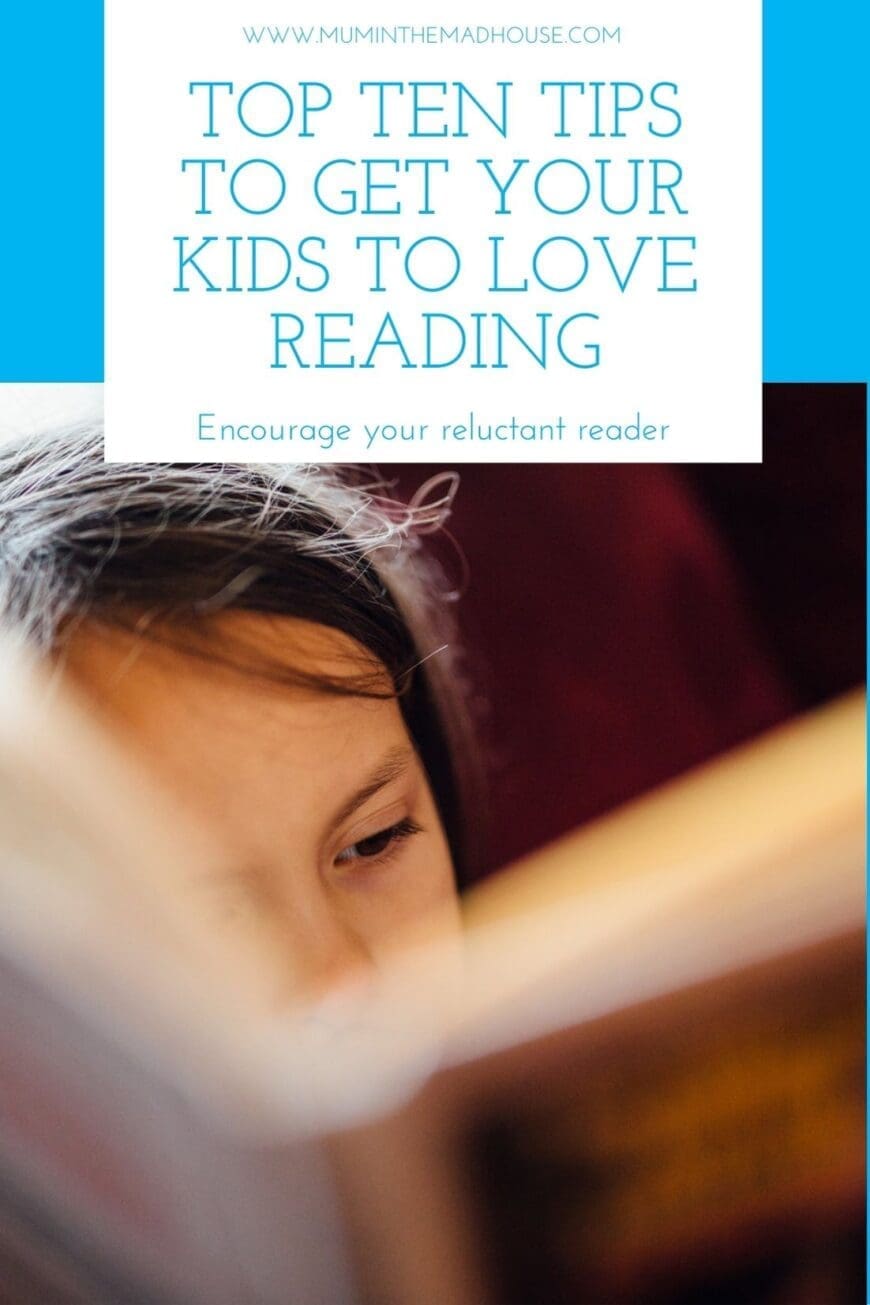Inspiring children to enjoy reading and develop their literacy skills can sometimes seem a daunting task. In an age in which parents are competing with multiple screens and devices, which have been relied upon to keep children entertained while so many of us have been working from home, the challenge has become even greater.

Literacy charity Bookmark works with schools to pair volunteers with children in Years 1-4 to help develop their reading skills and confidence away from the classroom, giving children and their teachers an added boost. The organisation has developed a series of fun and innovative tips to get kids hooked on reading.
Set up by Sharon Pindar, who knows first-hand the devastating impact of poor literacy can have, as a result of growing up with a mum who couldn’t read, the organisation is now taking on the challenge of inspiring a generation of young readers who have had their schooling disrupted over the past 18 months.
Sharon said: “My mum couldn’t do the basic things like applying for the benefits she was entitled to, writing notes to school when I was sick, cooking from a recipe or reading with the children that she adored. Mum found it really difficult to find a job, she lacked the basic confidence to challenge people when she wasn’t treated fairly.
“Today there are 7.1 million adults like my mum who struggle on a daily basis. We know that children that can’t read well will struggle at school and beyond. Bookmark is helping children develop the reading skills they need to succeed through our flexible, volunteer-led programme. For the children who need us, we’re changing their story.”
Sharon Pindar – Bookmark Chair of Trustees
As a parent, I have been there as one of my boys was a reluctant reader and I have shared tips on how to encourage boys to read and this is what inspired me to make free printable colouring bookmarks.
As half-term approaches and parents begin planning activities to keep their children engaged and spend quality time together, Bookmark’s experts Sacha Hamed, Head of Volunteering, who designed the charity’s unique volunteer training programme and Dr Kelda Green, who oversees the charity’s literacy resources, have given their top ten tips for turning your child into an avid page-turner.
Top ten tips to get your kids to love reading this half term

Think about your reader
Kelda: Before sitting your child down with a classic you adored, like The Chronicles of Narnia, consider what they’re interested in. It might seem obvious, but many parents fall down by starting their children with books they have no interest in. Is there a film or television programme they particularly enjoy? If so, is there an accompanying book or magazine you could buy or borrow from your local library? Have they started helping out in the garden or kitchen? If so, perhaps a recipe book or a story based in nature would be a good place to kick off your child’s reading journey.
Sacha: Each child is unique and therefore each young reader is unique. Don’t feel like you have to start with story books. Non-fiction, magazines, comics and poetry can all be good starting points. And don’t forget to adapt as you go along, taking note of what your child has and hasn’t enjoyed reading.
Be a reading role model
Kelda: Children learn many things through observation, learning a love of reading is no different. Make sure you have your own reading material around the house, whether a magazine, novel or newspaper, and that your child sees you picking these up when you’re having some down time.
Sacha: Seeing your parent or carer enjoying reading can be a game-changer for a child’s reading experience. Without a role model of reading for pleasure, children will only see it as something you do at school or that is associated with work. It’s just as easy for adults, especially those of us with children, to default to screen-time when we’re tired but it’s important to demonstrate how reading can help you to unwind.
Become an actor
Kelda: Expanding a child’s vocabulary isn’t just about reading the words on the page. If they’re struggling with something, act out what the word looks like so that they create an association with how it looks on the page. Performing parts of what you’re reading together also adds to the fun.
Sacha: You can also get your child to act out parts of what you’re reading. It helps to stop them getting fidgety to get up and move around during the process. Ask them to perform a scenario that they have just read for you.

Get arty
Kelda: Pictures or photos in a book or magazine can also help with comprehension and engagement. As adults, we also infer meaning from the surrounding context of words when we don’t know them. If your child comes across a word or phrase that they are unfamiliar with, encourage them to make a guess based on the pictures or photos they can see.
Sacha: Reading can be an immersive experience, and this can often mean engaging with the visual images writing creates in our minds. Starting to make those connections between images and words at a young age can create a life-long love of reading. You can begin a reading session by guessing what might happen based on the pictures.
Take risks
Kelda: Don’t be afraid to try out books or reading material that you know will include complicated vocabulary. If your child wants to read something about the design of diggers or species of dinosaurs, don’t put them off with your own apprehensions.
Sacha: There is no right way to learn how to read. Some children can list the Latin names for ten types of butterflies but struggle with day to day phrases. Always be led by their interests and passions and the rest will fall into place with time.
Get gaming
Kelda: Word searches, crosswords and puzzles are all great ways to learn new words in a fun way and without the pressure of getting to the end of a book. Just make sure that these games are age appropriate so that children don’t become demoralised.
Sacha: The internet is full of fun ways to get creative with your child’s reading. Printing out quizzes and crosswords is a good starting point. Many websites also include listening games, so children begin to associate the sounds of particular words with their meanings.
Share the load
Kelda: If your child is wanting to carry on with a reading session but is increasingly struggling with things, you can always step in and help out. Offer to read the next couple of sentences or the whole page if they need a break then they can come back to the content with their concentration refreshed.
Sacha: It’s not cheating to share the reading between you and can really help with making reading feel like quality time together. Ask your child how much help they want and go from there, or set up a ‘your turn, my turn’ structure from the beginning. This shows them that you’re in it together. Make sure to continuously encourage them but especially when they’re struggling. Applaud them when they return to being the primary reader after stumbling over anything. Listening to you reading will still help them to learn and understand how certain words are said. If you can, try to get them to keep following the words on the page when you read.
Ask questions
Kelda: Many children can become embarrassed about not understanding what they are reading. It’s important to regularly create a safe space for your child to say what their understanding of what they are reading has been so far, how they are finding it and if there’s anything that is proving difficult. This will help you to focus together on any sticking points as you move through it.
Sacha: Checking in regularly gives children a chance to ask about words or phrases they haven’t understood and makes reading an interactive and collaborative process, rather than it feeling like a test. Make sure to pause after every page or two to see how your young reader is doing. You can ask them questions like ‘what do you think is going to happen next?’, ‘do you think that’s true?’, ‘what do you think that character feeling?’ or ‘has anything like that ever happened to you?’.
Don’t be too ambitious
Kelda: When children are new to reading, they can find it hard to sit still and concentrate for long periods of time. Build up your reading sessions slowly and according to your own child’s enthusiasm. Imposing a timeframe makes reading a task rather than something you do for pleasure.
Sacha: Getting your child to sit down and open some reading material is an achievement in itself. Don’t put pressure on yourself or them to read a certain amount or in a certain time. Go with the flow and keep it fun. If they’ve had enough, you can always come back to it later or the next day.
Sound things out slowly
Kelda: Children can be put off when they see a long or unfamiliar word. Encourage them to break down the word into separate sounds. You can put your finger over the rest of the word while they focus on the first sound so that they don’t get distracted by the rest of it.
Sacha: Once children put the sounds of a new word together, they often register that they recognise it and it was the way that it looked on the page that was unfamiliar. Sounding things out together and helping children piece the sounds together can help to create a great sense of achievement.
Bookmark is recruiting more volunteers to help children aged 5-9 with reading. You can find out more and apply at bookmarkreading.org

Love these recommendations, well done! Another great activity: if your child has a favourite movie that also has a book, read the book and discuss similarities and differences :`)